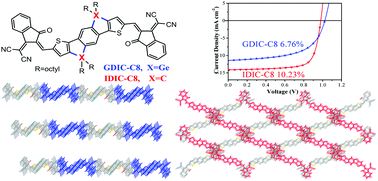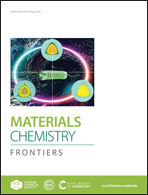Tuning the molecular geometry and packing mode of non-fullerene acceptors by altering the bridge atoms towards efficient organic solar cells†
Abstract
To investigate the effect of bridge atoms on the properties of non-fullerene acceptors, we designed two analogues by changing only one atom and report the first germanium based non-fullerene acceptor GDIC-C8. Compared to its analogue IDIC-C8, altering the bridge atom from carbon to germanium dramatically leads to a more planar molecular geometry. GDIC-C8 tends to form a 1D lamellar/slip-stack packing while IDIC-C8 represents a reticular motif packing in a single crystal. This unique structure greatly enhances the crystallinity of GDIC-C8 in single crystal and neat films, evidenced by X-ray single crystal diffraction and atomic force microscopy measurements. However, GDIC-C8 prefers to form edge-on π–π stacking when blended with a donor polymer PM6. In addition, the extremely high crystallinity of GDIC-C8 restrains competitively the crystallization of PM6 in the blend film. These features lead to an inferior photovoltaic performance of GDIC-C8 compared to IDIC-C8. This work systematically studies the effect of bridge atoms on molecular geometry and packing and reveals the importance of the bridge atom in the fused-ring semiconductors for the modulation of optoelectronic properties and device performance.



 Please wait while we load your content...
Please wait while we load your content...